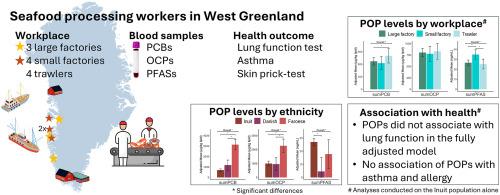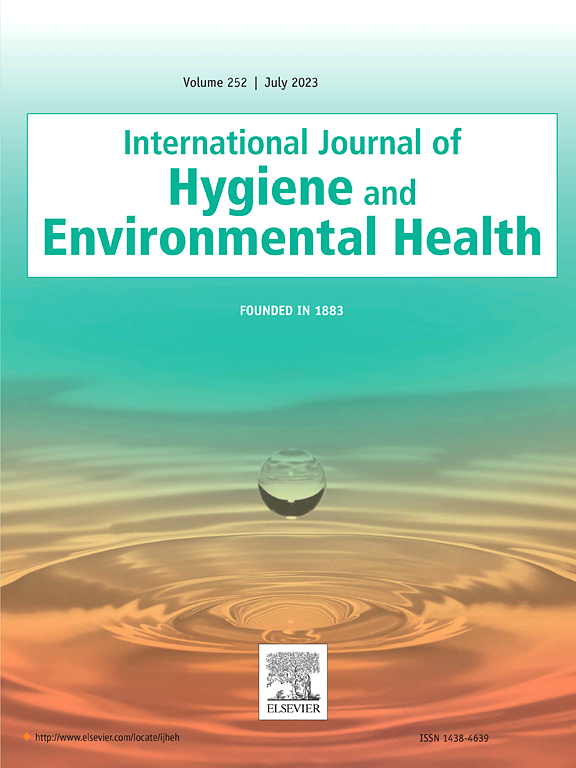西格陵兰海产品加工工人中的持久性有机污染物。
IF 4.4
2区 医学
Q1 INFECTIOUS DISEASES
International journal of hygiene and environmental health
Pub Date : 2024-11-07
DOI:10.1016/j.ijheh.2024.114484
引用次数: 0
摘要
格陵兰人口通过食用传统海洋食品(包括海洋哺乳动物)而高度暴露于持久性有机污染物(POPs)。渔业是格陵兰经济和文化特征的核心,雇用了约 15% 的劳动人口。本研究调查了格陵兰西海岸海产品加工工人接触持久性有机污染物的情况,包括多氯联苯 (PCB)、有机氯农药 (OCP) 以及全氟和多氟烷基物质 (PFAS)。我们研究了持久性有机污染物的决定因素,包括年龄、吸烟习惯、种族和工作地点。此外,我们还探讨了持久性有机污染物与哮喘、过敏和肺功能患病率之间的关联。这项研究在 2016-2018 年期间采集了 382 名工人的样本,他们主要是因纽特人后裔(占 93%),受雇于努克、西西米尤特和伊卢利萨特的三家大型工厂、定居点(Kangaatsiaq、Ikerasaarsuk、Sarfannguaq、Qeqertarsuaq)的四家小型工厂以及四艘工厂拖网渔船。收集的数据包括临床检查、有关种族、职业接触状况、健康指标和吸烟习惯的调查问卷,以及血清硒和持久性有机污染物分析。我们采用方差分析并对相关混杂因素进行调整,以评估不同组别(如种族组别和工作地点)之间持久性有机污染物的差异,并采用多元线性回归和逻辑回归评估持久性有机污染物与肺功能、过敏症和哮喘之间的关系。在不同种族群体中观察到了持久性有机污染物的显著差异;法罗群岛工人的亲脂性持久性有机污染物(lipPOPs;多氯联苯和 OCPs)浓度最高,而因纽特工人的全氟辛烷磺酸浓度最高。所有后续分析都以因纽特工人(n = 337)为重点。小型工厂工人的 PFAS 含量明显较高,其次是大型工厂和拖网渔船,而脂类持久性有机污染物则没有差异。工作场所之间的差异很可能是由于生活方式和饮食习惯的不同造成的,但也不能排除职业暴露的可能性。脂型持久性有机污染物和全氟辛烷磺酸的浓度与硒呈正相关,全氟辛烷磺酸与肺功能呈正相关。然而,在对硒进行调整后,PFASs 与肺功能之间的关联变得不显著,并逐渐趋于无效。在持久性有机污染物与哮喘或过敏症发病率之间没有发现明显的关联。与同一地区和同一时期的普通人群相比,海产品加工工人的持久性有机污染物水平高出 2-6 倍。海产品加工工人暴露于持久性有机污染物的水平较高,而且不同工作场所之间存在差异,这突出表明有必要对这一人群中持久性有机污染物的环境和职业来源进行进一步调查。这些发现可能有助于制定未来的公共卫生战略和监管措施,以减少北极地区人群的持久性有机污染物暴露。本文章由计算机程序翻译,如有差异,请以英文原文为准。

Persistent organic pollutants among seafood processing workers in West Greenland
The Greenlandic population is highly exposed to persistent organic pollutants (POPs) through the consumption of traditional marine food, including marine mammals. Central to Greenland's economy and cultural identity, the fishing industry employes about 15% of the working population.
This study investigated POP exposure, including polychlorinated biphenyls (PCBs), organochlorine pesticides (OCPs), and per- and polyfluoroalkyl substances (PFASs), among seafood processing workers at the Greenlandic west coast. We examined determinants for the POPs including age, smoking habits, ethnicity, and working place. Additionally, we explored the association between POPs and the prevalence of asthma, allergy, and lung function.
With samples taken during 2016–2018, the study encompassed 382 workers, primarily of Inuit descent (93%), employed across three large factories located in Nuuk, Sisimiut, and Ilulissat, four smaller factories in settlements (Kangaatsiaq, Ikerasaarsuk, Sarfannguaq, Qeqertarsuaq), and four factory trawlers. Data collected include clinical examinations, questionnaires on ethnicity, occupational exposure status, health indicators, and smoking habits, and serum selenium and POP analyses. We used ANCOVA with adjustment for relevant confounders to assess differences in POPs between groups (e.g. ethnic groups and working place), and multiple linear and logistic regressions were used to assess associations between POPs and lung function, allergy and asthma.
Significant differences in POPs were observed among ethnic groups; Faroese workers had the highest concentrations of lipophilic POPs (lipPOPs; PCBs and OCPs), while Inuit workers exhibited highest PFASs. All subsequent analyses were focused on the Inuit workers (n = 337). The PFASs were significantly higher in workers at small factories, followed by large factories and trawlers, whereas no differences were seen for lipPOPs. The differences between the working places were most likely due to differences in lifestyle and diet, but occupational exposures cannot be excluded.
LipPOP and PFAS concentrations associated positively with selenium, and PFASs positively associated with lung function. However, upon adjustment of selenium, the associations between PFASs and lung function became non-significant and attenuated towards null. No significant associations were found between POPs and the prevalence of asthma or allergy.
Compared to the general population in the same area and period, the seafood processing workers exhibited 2–6 times higher POP levels. The higher exposure level among seafood processing workers, as well as the difference across workplaces, underscore the need for further investigation of environmental and occupational sources of POPs in this population. These findings may contribute to future public health strategies and regulatory measures to reduce POP exposure in Arctic populations.
求助全文
通过发布文献求助,成功后即可免费获取论文全文。
去求助
来源期刊
CiteScore
11.50
自引率
5.00%
发文量
151
审稿时长
22 days
期刊介绍:
The International Journal of Hygiene and Environmental Health serves as a multidisciplinary forum for original reports on exposure assessment and the reactions to and consequences of human exposure to the biological, chemical, and physical environment. Research reports, short communications, reviews, scientific comments, technical notes, and editorials will be peer-reviewed before acceptance for publication. Priority will be given to articles on epidemiological aspects of environmental toxicology, health risk assessments, susceptible (sub) populations, sanitation and clean water, human biomonitoring, environmental medicine, and public health aspects of exposure-related outcomes.

 求助内容:
求助内容: 应助结果提醒方式:
应助结果提醒方式:


